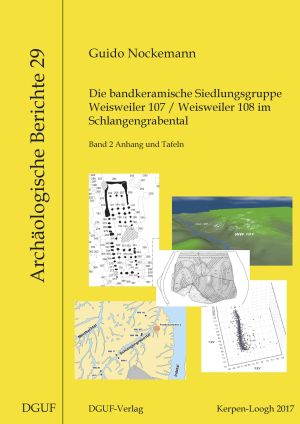Nockemann, Guido
Die bandkeramische Siedlungsgruppe Weisweiler 107 / Weisweiler 108 im Schlangengrabental: Band 1. Dokumentation und Auswertung
Die Aldenhovener Platte liegt seit über 40 Jahren im Fokus der Bandkeramik-Forschung. Im Vorfeld der rheinischen Braunkohletagebaue wurden und werden zahlreiche Grabungen und Prospektionen durchgeführt. Dieses Buch beschäftigt sich mit der Auswertung der archäologischen Funde und Befunde der bandkeramischen Siedlungsgruppe Weisweiler 107/Weisweiler 108 im Schlangengrabental der Aldenhovener Platte. Ziel der hier vorgelegten Untersuchung ist zum einem die Dokumentation und Vorlage der bandkeramischen Hinterlassenschaften und zum anderen die Herausarbeitung der Besonderheiten und Charakteristika der Siedlungsgruppe Weisweiler 107/Weisweiler 108 sowie die Klärung ihrer kulturhistorischen Position und Funktion in der rheinischen Bandkeramik. Hierzu werden ihre Hinterlassenschaften untersucht und mit anderen Siedlungen verglichen. Des Weiteren wird die Chronologie der Siedlungsgruppe vorgestellt und ihre Rolle in verschiedenen Netzwerken (Keramikverzierungen, Weitergabe von Silexartefakten etc.) analysiert. Damit schließt diese Arbeit eine Lücke, denn nun liegen alle bisher bekannten bandkeramischen Siedlungen im Schlangengrabental vor und werden in dieser Arbeit zusammenfassend betrachtet. Band 1 stellt die Analysen und ihre Ergebnisse vor.
Band 2 dokumentiert die Datengrundlagen der Untersuchungen.
Die bandkeramische Siedlungsgruppe Weisweiler 107 / Weisweiler 108 im Schlangengrabental: Band 2. Anhang und Tafeln
Die Aldenhovener Platte liegt seit über 40 Jahren im Fokus der Bandkeramik-Forschung. Im Vorfeld der rheinischen Braunkohletagebaue wurden und werden zahlreiche Grabungen und Prospektionen durchgeführt. Dieses Buch beschäftigt sich mit der Auswertung der archäologischen Funde und Befunde der bandkeramischen Siedlungsgruppe Weisweiler 107/Weisweiler 108 im Schlangengrabental der Aldenhovener Platte. Ziel der hier vorgelegten Untersuchung ist zum einem die Dokumentation und Vorlage der bandkeramischen Hinterlassenschaften und zum anderen die Herausarbeitung der Besonderheiten und Charakteristika der Siedlungsgruppe Weisweiler 107/Weisweiler 108 sowie die Klärung ihrer kulturhistorischen Position und Funktion in der rheinischen Bandkeramik. Hierzu werden ihre Hinterlassenschaften untersucht und mit anderen Siedlungen verglichen. Des Weiteren wird die Chronologie der Siedlungsgruppe vorgestellt und ihre Rolle in verschiedenen Netzwerken (Keramikverzierungen, Weitergabe von Silexartefakten etc.) analysiert. Damit schließt diese Arbeit eine Lücke, denn nun liegen alle bisher bekannten bandkeramischen Siedlungen im Schlangengrabental vor und werden in dieser Arbeit zusammenfassend betrachtet. Band 2 dokumentiert die Datengrundlagen der Untersuchungen.
Band 1 stellt die Analysen und ihre Ergebnisse vor.








